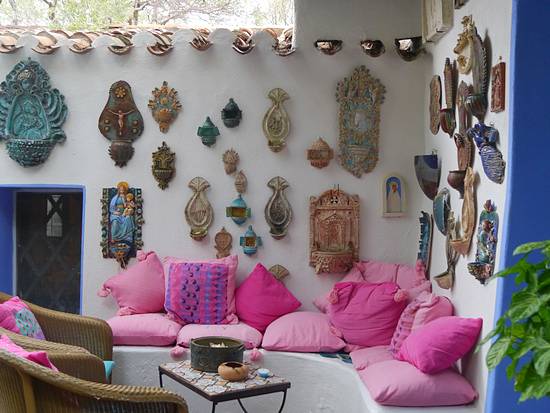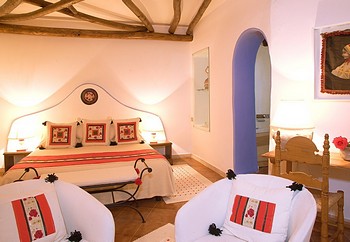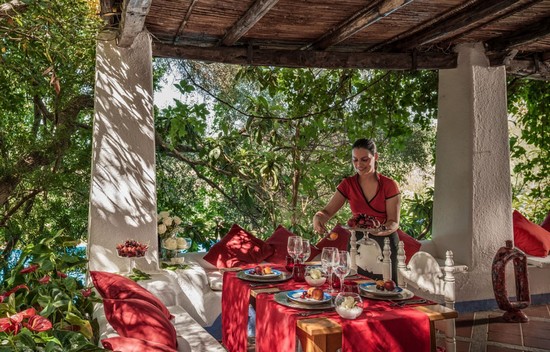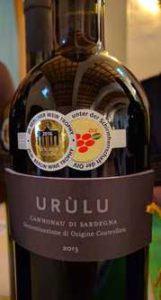
Hotel Su Gologone is a destination for design fans as well as wine-lovers. The whitewashed stucco walls and terracotta floor tiles serve as a blank canvas for an explosion of color. Potted geraniums and bright folk art dot every corner of the sprawling property. Bougainvillea crawls up the walls, its blossoms dangling overhead. Immense fig trees provide shade to outdoor patios and dining areas. The guest rooms, which range €121–€287 per night, are virtual galleries of local crafts—hand-loomed bed coverings, ancient pottery, brightly glazed ceramic folk art, furniture fashioned from local juniper wood, charmingly naïf paintings.
 Su Gologone began in 1967 as a small restaurant serving food next to the mountain spring by the same name. Since the location was remote, the family opened a small hotel that has grown over the decades into a designer destination. All the connected buildings cling to the topography of the hillside, creating multiple indoor and outdoor steps and staircases to access all the wings. The interiors overflow with folk art. (See the sitting area at the top of this post). Typical of the region, the hotel has no useful address. (You can send mail to Loc. Su Gologone, 08025 Oliena, Sardegna, Italia.) Reservations can be made by phone (+39 0784.287.512 or +39 0784.287.552) or at the multilingual web site (www.sugologone.it).
Su Gologone began in 1967 as a small restaurant serving food next to the mountain spring by the same name. Since the location was remote, the family opened a small hotel that has grown over the decades into a designer destination. All the connected buildings cling to the topography of the hillside, creating multiple indoor and outdoor steps and staircases to access all the wings. The interiors overflow with folk art. (See the sitting area at the top of this post). Typical of the region, the hotel has no useful address. (You can send mail to Loc. Su Gologone, 08025 Oliena, Sardegna, Italia.) Reservations can be made by phone (+39 0784.287.512 or +39 0784.287.552) or at the multilingual web site (www.sugologone.it).
Showcase of different Cannonau styles
 Su Gologone provides such an artistic atmosphere that many of the Cannonau producers like to use it to showcase their wines. The wine list in the restaurant is almost encyclopedic, and the producers frequently host potential distributors at the hotel. My little group organized by Renzo Peretto and Donatella Muscianese of Laore met with a handful of producers during our stay to sample some of their wines.
Su Gologone provides such an artistic atmosphere that many of the Cannonau producers like to use it to showcase their wines. The wine list in the restaurant is almost encyclopedic, and the producers frequently host potential distributors at the hotel. My little group organized by Renzo Peretto and Donatella Muscianese of Laore met with a handful of producers during our stay to sample some of their wines.
Sella & Mosca
Sella & Mosca (www.sellaemosca.it) began in 1899 as a vine nursery to help rebuild the Sardinian wine industry after the scourge of phylloxera. As such, the company takes a leadership role in rehabilitating some of the island’s indigenous grape varieties, most notably Vermentino among the whites and Cannonau among the reds. The main plantings in Alghero encompass 550 contiguous hectares (1359 acres), one of the largest vineyards in Europe.
The company makes three levels of Cannonau, including a very simple fruity style and a spicy “Dimonios” label made entirely for the domestic market. I recommend trying it in Italy. The low-yield grapes from old vines are fermented and aged in huge oak barrels and concrete. Its very spicy nose is followed by a velvet feel in the mouth and bright raspberry afternotes.
The wine widely available in the U.S. is Cannonau di Sardenga DOC Riserva. Retailing $16-$18 (in Massachusetts), this wine has everything you might ask of a food-friendly Cannonau. The brilliant ruby color and nose of violets and raspberries give way to a plummy mouth-feel flavor with hints of anise and rosemary. There’s just a touch of oak in the finish for an aristocratic balance.
Cantina Santa Maria la Palma
By contrast, Sella & Mosca’s neighbor in Alghero, Cantina Santa Maria la Palma (www.santamarialapalma.it), is a cooperative of about 300 members. In the 1960s, the farmers were all granted uncultivated land near the city to plant Vermentino and Cannonau. The winery’s principal production is Vermentino—it’s the largest in Sardinia—but it also makes two levels of Cannonau. The basic level, called “Le Bombarde”, is an easy-drinking young wine priced under $10 in the U.S. Its Cannonau di Sardenga DOC Riserva is less widely available but worth seeking out. For starters, it’s unusually low in alcohol for a Cannonau (13 percent), yet the tannins are fully ripe. It’s also a rarity among Cannonaus for using a substantial portion of American oak in the aging. This gives it a more pronounced vanilla note, but does present a smooth and elegant finish.
Viticolori della Romangia
This relatively new cooperative of 10 members formed in 1996. It is based in Sorso, in the far northwest corner of the island. Soils here are a hodge-podge of sand, clay, and limestone and the vineyards lie near the sea in the rain shadow of a high ridge. As a result, strong downdrafts and updrafts keep the vines well-ventilated. Although young, the cooperative’s “Radice” (a Cannonau di Sardegna DOC) seemed to really speak of its terroir. The fruit is very deep and clean—like an especially ripe Châteauneuf-du-Pape. The nose is closed, as you might expect from young vines, but the wine blossoms with food.
Cantine di Orgosolo
 Representing 19 small growers in the Locoe and Sorasai valleys, Cantine di Orgosolo (www.cantinediorgosolo) makes a entry-level Cannonau called “Neale” (meaning “honest man”). The blend includes 15 percent Bovale, which is immediately apparent on the nose by the aroma of leather. The taste, however, is bright raspberry and cherry. The winery’s “Luna Vona” organic wine is fermented on the stems with wild yeast. It has some slightly green tannins that pair well with robust meats. The flagship wine of this young cooperative (formed in 2006) is the most interesting. Called “Urùlu” after the archaeological site near the vineyards, it presents with a bold, sweet nose of raspberries and roses. Grown on granitic soils at 400-600 meters above sea level, the blend includes tiny percentages of some of Sardinia’s other indigenous grapes. Urùlu is said to be a sacred spot for the ancient Sardinians, and the wine has a certain sacramental quality.
Representing 19 small growers in the Locoe and Sorasai valleys, Cantine di Orgosolo (www.cantinediorgosolo) makes a entry-level Cannonau called “Neale” (meaning “honest man”). The blend includes 15 percent Bovale, which is immediately apparent on the nose by the aroma of leather. The taste, however, is bright raspberry and cherry. The winery’s “Luna Vona” organic wine is fermented on the stems with wild yeast. It has some slightly green tannins that pair well with robust meats. The flagship wine of this young cooperative (formed in 2006) is the most interesting. Called “Urùlu” after the archaeological site near the vineyards, it presents with a bold, sweet nose of raspberries and roses. Grown on granitic soils at 400-600 meters above sea level, the blend includes tiny percentages of some of Sardinia’s other indigenous grapes. Urùlu is said to be a sacred spot for the ancient Sardinians, and the wine has a certain sacramental quality.
